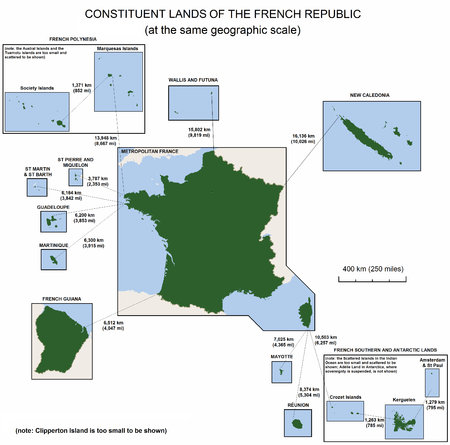Time in France

Metropolitan France uses Central European Time (heure d'Europe centrale, HEC: UTC+01:00) and Central European Summer Time (heure d'été d'Europe centrale: UTC+02:00). Daylight saving time is observed in Metropolitan France from the last Sunday in March (02:00 CET) to the last Sunday in October (03:00 CEST). With its overseas territories, France uses 12 different time zones, more than any other country in the world.
Notation
Overseas territories
The overseas territories of France use different timezones.
History
Before 1891, each town and city in Metropolitan France had its own time based on local solar time. In 1891, due to complications with railway timetables, time was unified in Metropolitan France and based on the solar time of Paris. In 1911, Metropolitan France adopted GMT+0 (the solar time of Greenwich) as its official time, and used it until 1940 (with GMT+1 used during the summers from 1916 to 1940).
In the summer of 1940, the German military authorities switched the occupied northern part of Metropolitan France to GMT+2 (German summer time), while the non-occupied southern part of Metropolitan France remained at GMT+1 (French summer time). The Vichy authorities kept GMT+1 (French summer time) during the winter of 1940–1941 and adopted GMT+2 (double summer time, which was the same as German summer time) in May 1941 in order to unify the railway timetables between occupied and non-occupied Metropolitan France. In 1942, 1943, and 1944 the whole of Metropolitan France thus used GMT+2 during the summer, and GMT+1 during the winter.[1]
At the Liberation of France in the summer of 1944, Metropolitan France kept GMT+2 as it was the time then used by the Allies (British Double Summer Time). In the winter of 1944–1945, Metropolitan France switched to GMT+1, same as in the United Kingdom, and switched again to GMT+2 in April 1945 like its British ally. In September 1945, Metropolitan France returned to GMT+1 (pre-war summer time), which the British had already done in July 1945. Metropolitan France was officially scheduled to return to GMT+0 on November 18, 1945 (the British returned to GMT+0 in on October 7, 1945), but the French government canceled the decision on November 5, 1945, and GMT+1 has since then remained the official time of Metropolitan France.
In 1976, daylight saving time (summer time) was reintroduced in Metropolitan France for the first time since WW2 because of the oil crisis, and since 1976 Metropolitan France has thus been at GMT+1 (now UTC+01:00) during the winter and GMT+2 (now UTC+02:00) during the summer. In 1996, daylight saving time was harmonized throughout the European Union by Directive 2000/84/EC, which moved the end of DST to the last Sunday in October.
Since GMT (now UTC) is Metropolitan France's "natural" time zone its use of UTC+1 in winter can be seen as a form of daylight saving time in winter, while Central European Summer Time (UTC+2) can be seen as a form of "double summer time."[2]
References
- ↑ Poulle, Yvonne (1999). "La France à l'heure allemande". Bibliothèque de l'école des chartes. 157 (2): 493–502. doi:10.3406/bec.1999.450989. Retrieved 29 March 2016.
- ↑ Thorsen, Steffen. "France and Spain kicks into "Double Summer Time"". Time and Date.com. Retrieved 11 January 2012.